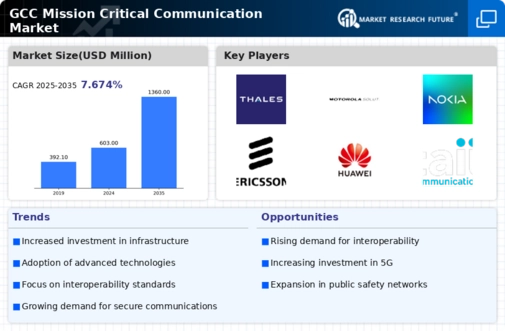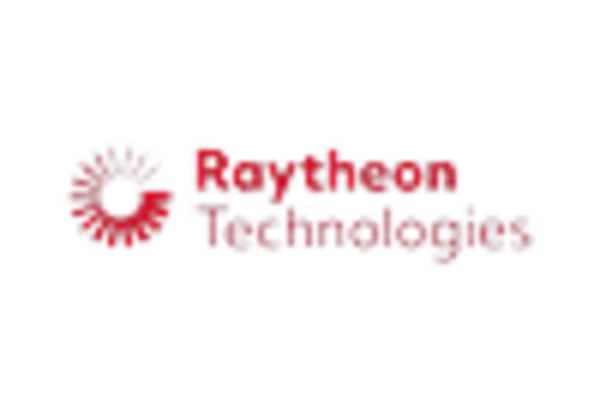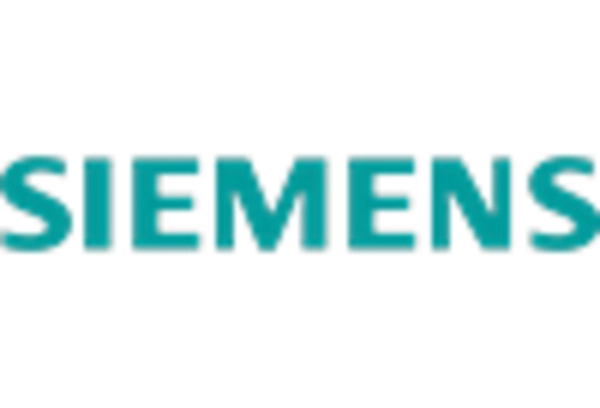Rising Public Safety Concerns
Public safety concerns are driving the growth of the mission critical-communication market in the GCC. Recent incidents have heightened awareness regarding the need for efficient communication during emergencies, prompting governments to prioritize the enhancement of their communication infrastructures. The allocation of funds for public safety initiatives is projected to increase by 15% annually, reflecting the urgency to improve response times and coordination among emergency services. This trend is likely to result in the adoption of advanced communication technologies that enable real-time data sharing and situational awareness. As public safety remains a top priority, the mission critical-communication market is expected to expand, with stakeholders seeking innovative solutions to address these pressing challenges.
Expansion of Smart City Initiatives
The mission critical-communication market is poised for growth due to the expansion of smart city initiatives across the GCC. Governments are increasingly investing in smart technologies to enhance urban living, which necessitates advanced communication systems for effective data exchange and management. The integration of mission critical-communication solutions into smart city frameworks is essential for ensuring public safety, traffic management, and emergency response. With an estimated investment of $20 billion in smart city projects by 2030, the demand for reliable communication systems is expected to rise significantly. This trend indicates a shift towards more interconnected urban environments, where mission critical-communication systems play a vital role in facilitating real-time information sharing and decision-making.
Growing Focus on Cybersecurity Measures
As the mission critical-communication market evolves, the emphasis on cybersecurity measures has intensified. The GCC region, with its strategic geopolitical position, faces various cyber threats that could compromise communication systems. Consequently, stakeholders are prioritizing the implementation of robust cybersecurity protocols to safeguard sensitive information and ensure operational continuity. Investments in cybersecurity solutions are projected to reach $5 billion by 2026, reflecting the urgency of addressing these vulnerabilities. This focus on cybersecurity not only protects communication networks but also instills confidence among users, thereby driving further adoption of mission critical-communication technologies. The integration of advanced encryption methods and real-time threat detection systems is likely to become standard practice, enhancing the overall resilience of communication infrastructures.
Regulatory Support and Standardization Initiatives
Regulatory support plays a pivotal role in shaping the mission critical-communication market in the GCC. Governments are actively establishing frameworks and standards to ensure interoperability and security across communication systems. For instance, the implementation of the GCC Unified Communications Framework aims to standardize communication protocols, thereby facilitating seamless integration among various agencies. This initiative is expected to enhance the effectiveness of emergency response operations, as different entities can communicate without barriers. Additionally, the regulatory environment encourages private sector participation, leading to increased innovation and competition. As a result, the mission critical-communication market is likely to witness a proliferation of advanced solutions that meet stringent regulatory requirements, ultimately benefiting end-users.
Increasing Demand for Reliable Communication Systems
The mission critical-communication market is experiencing a surge in demand for reliable communication systems, particularly in the GCC region. This demand is driven by the need for uninterrupted communication in emergency services, public safety, and defense sectors. As urbanization accelerates, the complexity of communication networks increases, necessitating robust solutions. The GCC governments are investing heavily in enhancing their communication infrastructure, with budgets exceeding $10 billion allocated for modernization projects. This investment is expected to bolster the capabilities of mission critical-communication systems, ensuring they can handle the growing volume of data and communication traffic. Furthermore, the integration of advanced technologies such as AI and IoT into these systems is likely to enhance their reliability and efficiency, making them indispensable for mission-critical operations.

















Leave a Comment